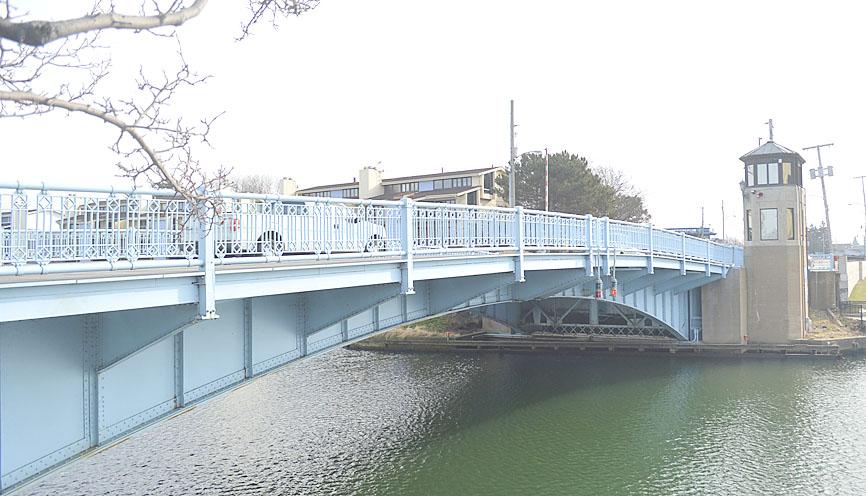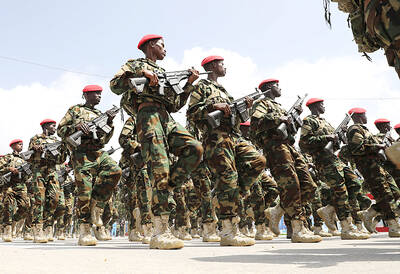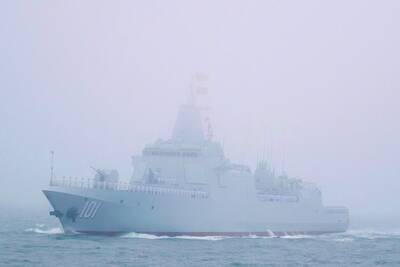The US’ infrastructure has scored near-failing grades for its deteriorating roads, public transit and storm water systems, due to years of inaction from the federal government, the American Society of Civil Engineers reported. Its overall grade: a mediocre “C-.”
In its “Infrastructure Report Card” released yesterday, the group called for “big and bold” relief, estimating that it would cost US$5.9 trillion over the next decade to bring roads, bridges and airports to a safe and sustainable level.
That is about US$2.6 trillion more than what the government and the private sector already spend.

Photo: AP
“America’s infrastructure is not functioning as it should, and families are losing thousands of dollars a year in disposable income as a result of cities having to fix potholes, people getting stuck in traffic or due to repairs when a water line breaks or the energy grid goes down,” said Greg DiLoreto, one of the group’s former presidents.
“It’s critical we take action now,” he said, expressing optimism that the federal government is now making it a “top priority.”
During former US president Donald Trump’s four years in the White House, his administration often held “Infrastructure Week” events and touted transportation improvements.
However, it was not able to push the US Congress to pass any broad plan to update the nation’s roads and bridges, rails and airports.
The overall “C-” grade on the US’ infrastructure — reflecting a “mediocre” condition with “significant deficiencies” — is a slight improvement from its “D+” grade in 2017.
The group cited in part state and local government and private-sector efforts, which have turned to new technology to pinpoint water main leaks and prioritize fixes.
However, of the 17 categories making up the overall grade, 11 were in the “D” range that indicated a “significant deterioration” with a “strong risk of failure.”
They included public transit, storm water infrastructure, airports and roads and highways, which make up the biggest chunk of US infrastructure spending at US$1.6 trillion, the group said.
Four areas got “C”s: bridges, which dropped from a “C+” to a “C” this year, energy, drinking water and solid waste. Just two areas — ports and rail — scored higher, with a “B-” and “B” respectively.
US President Joe Biden’s administration and lawmakers in the past few weeks have begun laying the groundwork for a long-sought boost to the nation’s roads, bridges and other infrastructure of US$2 trillion or more, to be unveiled after Congress approves legislation on COVID-19 relief.
US Secretary of Transportation Pete Buttigieg, who has been meeting with lawmakers about the effort, has said the aim would be to rejuvenate the post-pandemic economy and boost crumbling roads and bridges, while encouraging alternative forms of transportation to cars, as well as create thousands of green jobs by making environmentally friendly retrofits and public-works improvements.
“This report card is a warning and a call to action,” Buttigieg told reporters. “A generation of disinvestment is catching up to us, and we must choose whether to allow our global competitors to pull ahead permanently, or to invest in the safety, equity, resilience and economic strength that superior infrastructure can bring to Americans.”
Buttigieg on Tuesday announced the first low-cost federal transportation loan in the Biden administration, up to US$448 million to Texas for toll-road projects in Austin to ease congestion, touting bike-friendly features such as a planned 3m-wide paved sidewalk for cyclists and pedestrians with access to trails.
“As communities across the country continue to battle the pandemic, we are committed to being a partner to help them save money, reduce congestion and improve mobility, safety and accessibility,” Buttigieg said.

END OF AN ERA: The vote brings the curtain down on 20 years of socialist rule, which began in 2005 when Evo Morales, an indigenous coca farmer, was elected president A center-right senator and a right-wing former president are to advance to a run-off for Bolivia’s presidency after the first round of elections on Sunday, marking the end of two decades of leftist rule, preliminary official results showed. Bolivian Senator Rodrigo Paz was the surprise front-runner, with 32.15 percent of the vote cast in an election dominated by a deep economic crisis, results published by the electoral commission showed. He was followed by former Bolivian president Jorge “Tuto” Quiroga in second with 26.87 percent, according to results based on 92 percent of votes cast. Millionaire businessman Samuel Doria Medina, who had been tipped

ELECTION DISTRACTION? When attention shifted away from the fight against the militants to politics, losses and setbacks in the battlefield increased, an analyst said Recent clashes in Somalia’s semi-autonomous Jubaland region are alarming experts, exposing cracks in the country’s federal system and creating an opening for militant group al-Shabaab to gain ground. Following years of conflict, Somalia is a loose federation of five semi-autonomous member states — Puntland, Jubaland, Galmudug, Hirshabelle and South West — that maintain often fractious relations with the central government in the capital, Mogadishu. However, ahead of elections next year, Somalia has sought to assert control over its member states, which security analysts said has created gaps for al-Shabaab infiltration. Last week, two Somalian soldiers were killed in clashes between pro-government forces and

Ten cheetah cubs held in captivity since birth and destined for international wildlife trade markets have been rescued in Somaliland, a breakaway region of Somalia. They were all in stable condition despite all of them having been undernourished and limping due to being tied in captivity for months, said Laurie Marker, founder of the Cheetah Conservation Fund, which is caring for the cubs. One eight-month-old cub was unable to walk after been tied up for six months, while a five-month-old was “very malnourished [a bag of bones], with sores all over her body and full of botfly maggots which are under the

BRUSHED OFF: An ambassador to Australia previously said that Beijing does not see a reason to apologize for its naval exercises and military maneuvers in international areas China set off alarm bells in New Zealand when it dispatched powerful warships on unprecedented missions in the South Pacific without explanation, military documents showed. Beijing has spent years expanding its reach in the southern Pacific Ocean, courting island nations with new hospitals, freshly paved roads and generous offers of climate aid. However, these diplomatic efforts have increasingly been accompanied by more overt displays of military power. Three Chinese warships sailed the Tasman Sea between Australia and New Zealand in February, the first time such a task group had been sighted in those waters. “We have never seen vessels with this capability